When it comes to making natural goat milk soap, there are really only two basic methods - cold process and hot process - and the names do describe the main difference between the two.
With both of these methods, you take (non-soap) raw ingredients and through the miracle of chemistry, create a new substance - soap. The main difference is that hot process soap is made with added heat while cold process soap generates its own heat through the saponification (soapmaking) reaction.
There are other ways to recreate soap (such as rebatching or using a melt and pour base), but as far as I know, hot process and cold process are the only ways to make soap from scratch with the ingredients you desire.
What Does Cold Process Soapmaking Look Like?
All the goat milk soaps at Goat Milk Stuff are created with the cold process method. The first step is choosing which blend of fats and oils we want to use in our formula. The fats and oils are chosen based on the finished soap we are trying to achieve. Sometimes we want something really cleansing (like our Laundry Soap). Sometimes we want something incredibly gentle (like the Castile Goat Milk Soap we recommend for newborns or cancer patients).
 "I have suffered extremely dry skin all my life. I bought the goat milk and olive oil soap (Castile) because I needed an especially gentle body soap during a medical treatment. Not only was the soap exceptionally gentle on my beleaguered skin, but to my utter surprise, my dry skin was no longer dry, cracked and flaky. I stopped using the soap after my treatment ended and the dry skin came right back! I'm ordering more of this soap right away!" - Jane S. |
Sometimes we want something for people with skin conditions such as eczema, psoriasis, or rosacea (like our Purity Goat Milk Soap). The oils we choose will help determine the properties of the finished soap.
 "My husband has skin issues and he uses Purity goat milk soap only! It has helped him so much. Thank you!!" - Virginia E. |
Once we've determined our oil blend, we then use a lye calculator to determine how much lye and goat milk is needed. This is fairly simple when it comes to how much lye to use. But it's a little more complicated when it comes to determining the amount of goat milk.
We always extensively test the amount of goat milk we add to our soaps. If we use too little goat milk, then we don't achieve the full benefits of adding the goat milk to our natural soap. If we use too much goat milk, then the bar of soap doesn't last very long and melts away far too quickly. Through extensive testing, we've found what is the perfect amount of goat milk that produces a long-lasting, yet very moisturizing bar of natural goat milk soap.
 "I love this company and the products they offer! I love the emails they send with all the information also! This Lavender bar has a lovely scent and lasts a long time. I can tell a difference with my skin when I use it. My skin feels soft and moisturized." - Michelle A. |
Once the formula is determined, it's time to make the soaps. The cold process method looks something like this:
- Carefully measure and melt any oils/fats that aren't liquid at room temperature.
- Add the liquid lye solution and any extra goat milk that our recipe calls for.
- Add any scents, colors, additives.
- Mix the soap until it starts to thicken (a point called trace).
- Pour into molds.
- Let sit overnight.
- Unmold soap.
- Cut soap.
- Let sit at room temperature for a minimum of 6 weeks to cure.
That's a fairly simplistic description, but it covers the basics. We choose to make goat milk soap with this cold process method as opposed to hot process because our testing shows it makes the mildest, longest-lasting bars of soap.
 "I love your Castile Olive Oil Goat Milk Soap!! I am a breast cancer survivor/ thriver. My skin was so dry as a result of the chemotherapy and I was using a lot of lotion to moisturize. I was heading towards my radiation therapy and during my consultation, was told to use a mild soap on my affected skin. I knew of some commercially made mild soaps, but, decided to search online for a mild soap for my skin. I was guided to Goat Milk Stuff & I’ve learned during my journey to pay attention to these “nudges”. So, I purchased my first bar of your Castile Olive Oil soap. My skin has lost it’s dryness and is so soft! I love all of the Goat Milk Stuff products that I’ve tried so far and have already purchased my next bar Castile Olive Oil Goat Milk Soap! Thank you for such an amazing pure product!" - Cynthia S. |
We purposely do not add any heat to our soaps to speed up the curing process. We don't add heat during the mixing phase and we don't add heat during the curing phase because we want the soap to cure on its own.
Many soapmakers add heat during this time because it speeds up the saponification reaction and makes the soap ready to be used in a shorter time period. This can increase product turn around time which can be good for business.
But we've always strongly believed that what is best in the long-term for our business is to provide the best bars of natural goat milk soap we possibly can. And because that is our main goal, we don't take shortcuts such as adding heat to rush the process. We believe this is better for the essential oils and other botanicals that are added to our goat milk soaps and that it is ultimately better for your skin! And we can be very patient when the end result is soap that can help not just healthy skin, but help people suffering with dry skin and skin conditions such as eczema or psoriasis.
 "Tea Tree soap is lovely. The scent is not overpowering and you will not walk out of the shower smelling like you dabbed on some essential tea tree oil. It is light and refreshing. Thus far it works well on heat rash and acne. This has become a family favorite." - Cherylynn G. |
During the cold process curing time, the saponification (soapmaking) reaction is continuing. While much of the reaction occurs within the first 24 hours (which is why the soap can be unmolded and cut at that point), it does continue for several weeks. While the soap sits on the curing racks, seemingly doing nothing, not only is water evaporating (which helps the bar to be firmer and last longer), but the last of the lye is continuing to react with the oils to create soap and glycerin. By the time the six weeks are up, there is no more lye left. This makes the soap more gentle.
Curing Goat Milk Soap
It's hard to get a full idea of the size of our Soaproom unless you've been in it, but believe it or not, most of the work we do making our products and packaging orders takes place in only about half of the building. The other half is devoted to our many curing trays of goat milk soaps.
 "I love ALL of GMS soaps. I just ordered the Oatmeal Milk & Honey MEGA bar. The scent is heavenly. The bar leaves your skin soft (Not dry like a lot of soaps) and you smell warmly of honey. Thanks to PJ and Family ♥️" - Michelle H. |
The older a bar of soap is, the longer it will last. So we let our soap cure in the Soaproom for a minimum of six weeks before we will ship them out to you. This allows the soaps to dry after the soap-making process and they lose "water weight" during this time.
After six weeks, the bars have hardened and can be stored, bagged, or immediately shipped out.
What's Better - Cured or Uncured Goat Milk Soap?
It's all about personal choice! (But no matter what you choose, soap must cure before you can use it.)
Sometimes, we have customers email us who love our soap but would prefer to let the bars cure in their own homes. There are a number of reasons why some people prefer this:
- The uncured bars are softer so they can be cut into smaller pieces if desired.
- Uncured soap is sold in a bulk form, such as mega bars, so it will last a long time.
- Curing soap smells really good!
Curing soap does two main things. First, it allows the soap to dry out and harden so that it will last longer. Second, it allows it to fully finish the saponification process so it is the mildest bar of soap possible.
 "I've been using goat's milk stuff soap for almost a year now and I'll always make sure to have it stocked. Currently using the Frankincense and Myrrh and, like all your soaps, it's wonderful and my skin loves it. I live in New Mexico and it is very dry here. Using goat's milk soap keeps my skin from itching and drying out. I was storing my stock in plastic bags in my linen closet, but since reading your article in the newsletter the other day, I learned that it's best to let it be exposed to air. Appreciate your articles and the tips. Love your company and your family." - Robbin F. |
We allow our soap to cure for a full 6 weeks, but if you are super anxious you can use it at 4 weeks. The soap is safe to use from 2-4 weeks cured, but it will not last very long if you do.
To cure, you want to place your soap in a place out of direct heat or sunlight where it can get airflow. Do not put it in a sealed container. When we first started making soap, we placed the bars on the wire racks in our closets. Do not place it on metal or on finished wood (put a towel down first if you want to use that). If you are placing the soaps on a solid surface, you will want to turn them at least once a week.
This is a video Emery did several years ago. We no longer have the 3 pound logs available for sale, but the other information is good.
The requests we receive for uncured soap have led us to make uncured mega bars available for sale every once in a while. They are time-consuming to make so we are unable to offer them year-round. However, if you're interested in a custom batch of goat milk soap, we'd be happy to see if we can help! Simply send us an email to soap@goatmilkstuff.com.
Cutting Goat Milk Soap
We recommend that you cut your soap with a mitre box and putty knife. You can watch Emery demonstrate how it is done in this video:
It is possible to cut soap with a kitchen knife, but we don't recommend it as the knife can slip.
If you order goat milk soap that you intend to cut, please cut it as soon as you receive it. The longer soap cures, the more difficult it is to cut.
We have soap in several different sizes (see goat milk soap size comparison chart) and do not offer custom cutting into smaller sizes. Thanks for understanding!
Glycerin in Goat Milk Soap
As I mentioned, an important by-product of the cold process soapmaking method is glycerin. The glycerin that is produced by this method is perfectly in balance within the soap. Most commercial soap manufacturers regularly remove the glycerin from their soap and sell it because it is a very valuable by-product. This can cause commercial soap to be more drying because the naturally occurring glycerin has been removed (and often added to expensive moisturizers).
Glycerin works well with your skin because it is a humectant. A humectant attracts moisture which means it can help moisturize your top layer of skin. But it is important that the glycerin be in balance. If you use too much glycerin, it can actually pull too much moisture out of your second layer of skin which is why you should never use straight glycerin on your skin.
In our cold process goat milk soap, there is just the right amount of naturally occurring (not synthetic) glycerin.
 "Ocean Soap smells divine. So fresh and moisturizing. Truly a favorite." - Christine G. |
Cold Process Soap is Not a Detergent
It should also be noted that a cold process soap is just that - soap. It is not a detergent. There are several differences between soap and detergent but the main thing to know is that detergents are synthetic formulations that were created to mimic how soap cleans.
When there was a shortage of animal and vegetable fats (natural soapmaking ingredients) during the world wars, scientists created detergents using petroleum, as a substitute for soap. So although detergents and soaps clean in the same manner, they are created differently.
 "I am really enjoying my Goat Milk Stuff purchase! The Fiji Island soap smells amazing! Feels great on the skin and I am noticing less dryness all over. I could make this my regular shower soap, easily. Glad I found you and Thank You!" - Sarah J. |
Soapmaking combines fats and oils that are plant or animal based with an alkali (lye) to produce soap in a process called saponification. Detergents are primarily petrochemical (crude oil) and sulfuric acid based surfactants. Soap is a natural surfactant which means it allows water to clean better by keeping the water molecules from sticking to themselves (like a drop of water staying bubbled up on a table). When the water can spread out, it more easily interacts with the oil and grease and can then more easily wash it away.
At Goat Milk Stuff, we believe that natural is better for your skin. That's why all of our soaps are made with the goat milk from our own healthy, pasture-raised goats. That's why we use the cold process method and why we don't add heat to our soaps or try to speed up the process.
We believe that once you feel the difference our natural goat milk soap makes on your skin, you'll be a believer too!
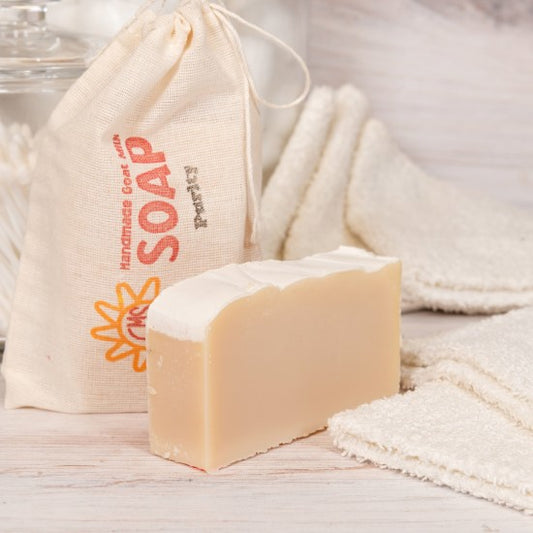
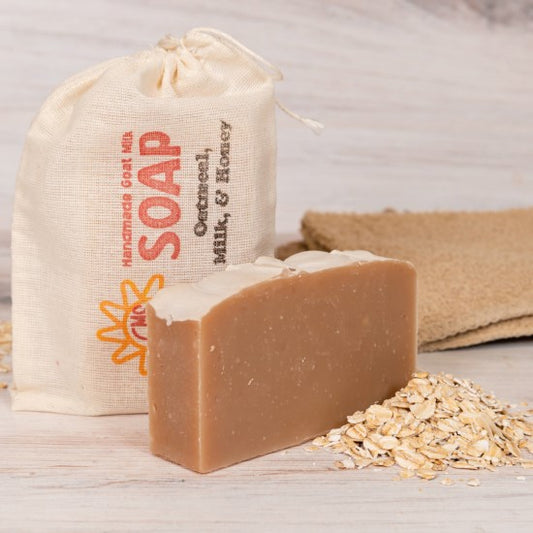
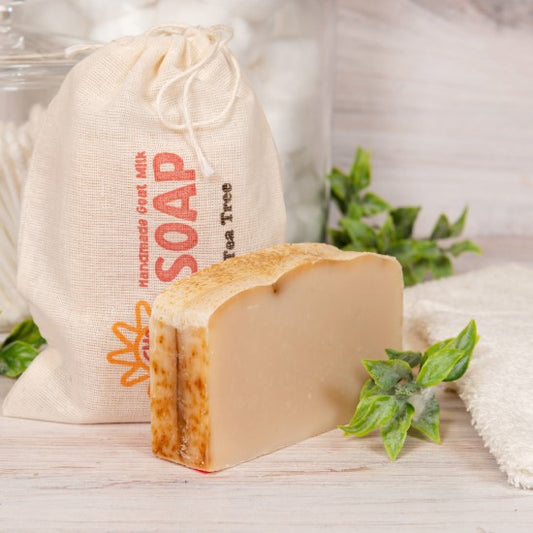
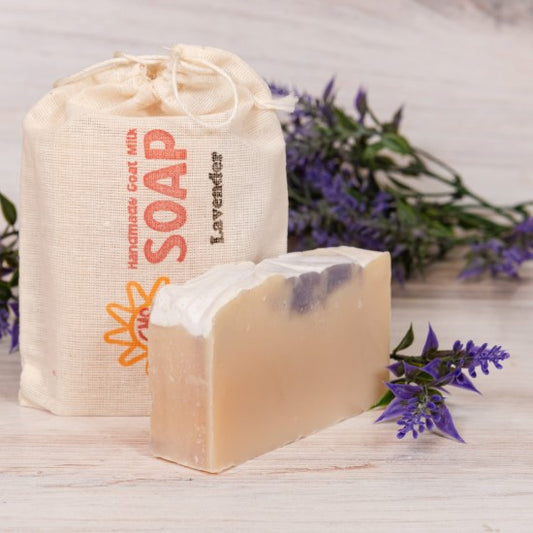

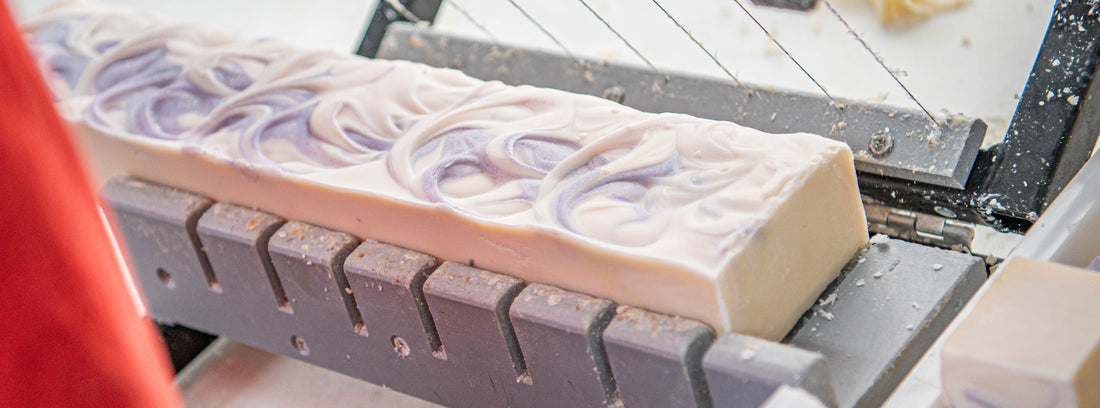
2 Responses
Goat Milk Stuff
I’m so glad to hear it! :)
PJ
sandra boehler
I love & appreciate all the information you share ! :) Love your soaps too !